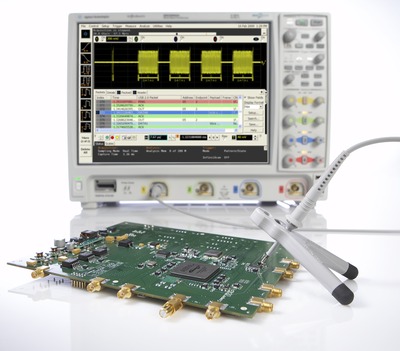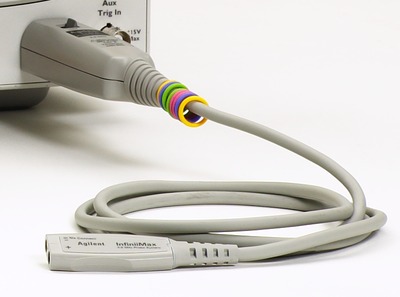Choosing the best oscilloscope probes
By Jae-yong Chang and Kenny Johnson, Agilent Technologies
Wednesday, 23 May, 2012
Selecting the right probe for an application is the first step towards making reliable oscilloscope measurements. There are a number of different types of oscilloscope probes to choose from, but they fall into two major categories: passive and active probes.
A simple distinction between the two types is that active probes require external probe power to power the active components in the probe such as transistors and amplifiers and they offer higher-bandwidth performance than passive probes, which do not require external probe power. There are many different types of probes under each category, and each has an area where it performs best.
Passive probes
The most common type of scope probes today is the passive voltage probe. Passive probes can be largely divided into high-impedance-input passive probes and low-impedance, resistor divider passive probes.
The high-impedance-input passive probe with a 10:1 division ratio is probably the most commonly used probe; it is shipped with most low- to mid-range oscilloscopes.

The probe tip resistance is typically 9 MΩ, which gives a 10:1 division ratio (or attenuation ratio) with the scope’s input when it’s connected to a 1 MΩ input of a scope. The net input resistance seen from the probe tip is 10 MΩ. The voltage level at the scope’s input is then 1/10th of the level of the voltage at the probe tip, which can be expressed as:
Vscope = Vprobe * (1 MΩ/ (9 MΩ + 1 MΩ))
Compared to active probes, passive probes are more rugged and inexpensive. They offer a wide dynamic range (>300 V for a typical 10:1 probe) and high input resistance to match a scope’s input impedance. However, they impose heavier capacitive loading and have lower bandwidths than active probes or low-impedance (z0) resistor-divider passive probes.

Let’s look at the low-impedance resistor divider probe. The low-impedance resistor divider probe has either 450 or 950 Ω input resistance to give 10:1 or 20:1 attenuation with the 50 Ω input of the scope. That input resistor is followed by a 50 Ω cable that is terminated in the 50 Ω input of the scope. It is important to remember that the scope must have a 50 Ω input to use this type of probe. The key benefits of this probe include low-capacitive loading and very high bandwidth - in the range of a couple of GHz - which helps to make high accuracy timing measurements.
In addition, this is a low-cost probe compared to an active probe in a similar bandwidth range. This probe would be used in applications such as probing ECL circuits, microwave applications or looking at 50 Ω transmission lines. The one critical trade-off is that this probe has relatively heavy resistive loading, which can affect the measured amplitude of the signal.

Figure 3: Low-impedance resistor divider probe features low capacitive loading and wide bandwidth.
Active probes
A scope with more than 500 MHz of bandwidth is an active probe. In spite of its high price, the active probe is the tool of choice for high bandwidth performance. They typically cost more than passive probes and their input voltage is typically limited, but because of their significantly lower capacitive loading, they give more accurate insight into fast signals.
By definition, active probes require probe power. Many modern active probes rely on intelligent probe interfaces that provide power and serve as communication links between compatible probes and the scope. Typically, the probe interface identifies the type of probe attached and sets up the proper input impedance, attenuation ratio, probe power and offset range as needed.

Bandwidth considerations
Higher bandwidth is a clear advantage of active probes over passive probes. One thing probe users often overlook is the effect of the connection to the target, which is called “connection bandwidth”. Even though a particular active probe may have an impressive bandwidth specification, the published specified performance may be under suitable probing conditions. In a real-world probing situation, which would include using probing accessories to attach to the probe tips, the active probe’s performance may be much worse than the published specified performance. The real-world performance of an active probing system is dominated primarily by the ‘connection’ system. Parasitic components to the left of the point labelled VAtn in Figure 5 are the driving factors in determining the performance of a real-world active probing system in high-frequency applications.

Figure 5: Parasitic components (to the left of the point labelled VAtn) are the driving factors in determining the performance of a real-world active probing system in high-frequency applications.
As an example, Agilent’s N2796A 2-GHz single-ended active probe provides 2 GHz of bandwidth with a probe tip and a 2 cm long offset ground. With this best-case set-up, 2 GHz of probe bandwidth is produced. If the tip is taken off and and replaced with a 10 cm dual-lead adapter, the probe bandwidth drops to 1 GHz. With additional clips attached to the dual-lead adapter, the probe bandwidth is further reduced to 500 MHz. So the key here is that shorter input leads are better for probe performance.

Probe loading effect
Now, let’s talk about a probe’s input impedance and input loading. Many people think that probe input impedance is a constant number. Some may say that the probe has a kiloΩ, megaΩ or even a 10 megaΩ input impedance, but that isn’t constant over frequency. Input impedance decreases over frequency.
At DC and low frequency ranges, the probe’s input impedance starts out at the rated input resistance, say 10 MΩ for a 10:1 passive probe, but as the frequency goes up, the input capacitance of the probe starts to become a short, and the impedance of the probe starts to drop. The higher the input capacitance, the faster the impedance slope drops.

Figure 7 shows a comparison between a 500 MHz passive probe and a 2 GHz active probe. At ~10 kHz of a crossover point and beyond, the input impedance of the active probe is higher than that of the passive probe. Higher input impedance means less loading on the target signal, and less loading means less effect or less disruption of the signal.
At 70 MHz bandwidth on the chart, the input impedance of the passive probe goes down to ~150 Ω, while the input impedance of the active probe is about 2.5 kΩ. There is a significant difference between them. If, for example, a system that had something like 50 or 100 Ω source impedance was used, that passive probe is going to have a significantly higher effect on the signal due to probe loading.
In that frequency range, connecting that passive probe is like hanging a 150 Ω resistor on a circuit. If this can be tolerated, this passive probe is going to be fine. If not, then this probe would be an issue, and a probe with higher impedance at a high frequency range like an active probe would be more suitable.
When considering the right measurement tools for scope application, probing is often an afterthought. Many customers usually select the scope first based on the bandwidth, sample rate and channel count needs, and then worry about how to get the signal into the scope later. Selecting the right probe for an application and how to use the probe is the first step towards reliable scope measurements.
A passive probe is a safe choice for general-purpose probing and troubleshooting, while for high-frequency applications, an active probe gives much more accurate insights into measuring fast signals. Although many active probes in the market have an impressive bandwidth specification, remember that the real-world performance of an active probe is dominated primarily by how the probe is connected to the target. A simple rule of thumb to keep in mind is that a shorter input lead is better if it’s for high fidelity measurement.
Achieve accurate RF measurements by understanding spectral purity
Selecting a signal generator with high spectral purity ensures that the measurements signify the...
Signal generators: does analog or digital make a difference?
With so many options, it's important to understand which signal generator is best to achieve...
Using AI to build your next-gen wireless system
The central challenge engineers face when designing wireless systems and networks is their...



